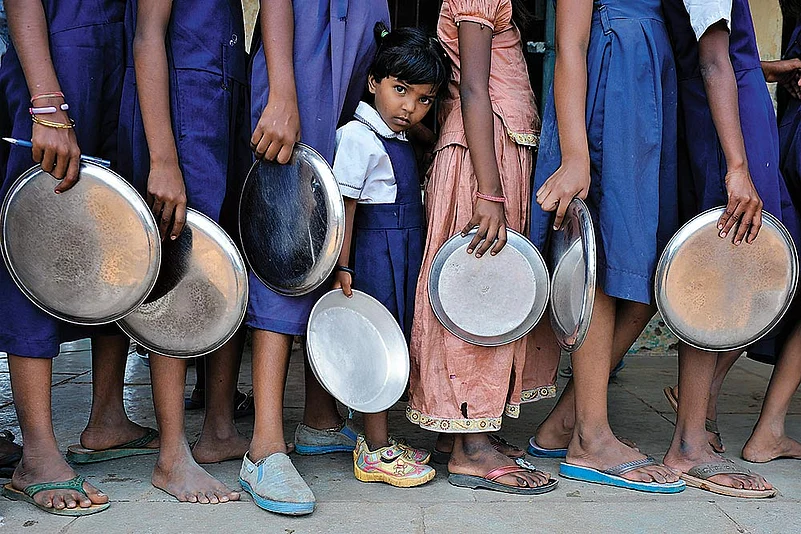One unremarkable morning last year, Jhingru died. Shrunken, emaciated and grey, he looked older than his 42 years. His family members say he had not eaten for ten days: there was no food at home, no money, nothing. As the word spread, district officers arrived, photographers in tow. In the end, Jhingru’s body was taken away for autopsy. The officers needed to know if he had really died of starvation or the family was cadging for sarkari largesse. Ironically, it was a day of mourning for the nation, too. No, not for Jhingru, but for India’s $140-million moon mission, Chandrayaan 2, that missed its tryst with destiny.
Mahua Laddoos To Leftover Food From College Canteens -- Meet Nutrition Warriors Aiming To Conquer Starvation
Twenty five lakh Indians die of malnutrition-linked diseases every year. But citizens are coming forward with innovative ideas to stem the rot in the food and health system

Destiny was never Jhingru’s friend. He lived at the edge of a Jharkhand village that doesn’t appear on Google maps. His home was a cracked mud tenement, like that of one crore Indians. Hunger was his bedmate, making him a statistic: one among 19 crore citizens, one-third of the world’s malnourished living in India. Life, death and everything in between was undermined by the rumblings in his stomach, like 25 lakh Indians who die of diseases linked to malnutrition every year. In death, however, Jhingru attained some fame, as a war of words broke out, with the government denying that starvation was the cause of his death.
There are stories that die silent deaths. Or appear as a blip in the hectic competition for news. But sometimes that blip ignites a spark of inspiration. Many such sparks die out. Just sometimes, a spark becomes a flame, putting ideas in motion, setting off a momentum, reaching a point where something is worth creating, worth preserving, worth spreading.
Sometimes, the magic of ideas can change the world with a bang: an Archimedes calculates density and volume in the bathtub, a Newton comes up with the law of universal gravity as an apple falls on his head, an Alexander Fleming stumbles upon penicillin on a discarded lab dish or an Arthur Fry imagines Post-it notes as he sings in a church choir. But “aha! moments” also stir up a gentle revolution, change the world quietly, courageously, without much fuss. People who come up with such ideas are change agents, who can see the patterns around them, join the dots, figure out solutions, organise fluid teams and lead collective action.
It was one evening of excess three years ago that turned Chandra Shekhar Kundu of Asansol, West Bengal, into a change agent. There was so much surplus food at his son’s birthday that a lot had to be thrown out. Hours later, he came across two children, rummaging food in a garbage can. Something happened inside him, a light turned on, and he made it his life’s priority to spread the word on food wastage and feed impoverished children, as many as he can. He now runs FEED, which collects excess untouched food from college and office canteens and distributes it among nearly 200 children in Calcutta, Asansol and Delhi every day.?? ?
He is not alone. Shashanka Ala, deputy commissioner of Lawngtlai, Mizoram, came up with the idea of nutri-gardens in schools, when she enrolled her one-year-old son in the nearest anganwadi and noticed the absence of hot, cooked meals, fresh fruits and vegetables in his take-home ration. Her idea, Kan Sikul, Kan Huan (My School, My Farm), has been made the model for all schools and colleges in Mizoram now. Similarly, a chance visit to the Tata Memorial Hospital in Mumbai was the tipping point for Purnota Dutta Bahl, when she realised India loses children in treatment not to cancer but to malnourishment. She quit her corporate job to set up Cuddles Foundation, to provide holistic nutritional support to underprivileged children fighting cancer.?
In insurgency-hit Jagdalpur of Chhattisgarh, a young mic-robiologist, is giving longer shelf-life to nutrient-dense Mahua laddoos, out of an interaction with ten tribal women. In Rajasthan’s Tiloniya, another young biotechnologist and her team are reinventing traditional tribal recipes to fight anaemia. A young collector in Umaria, Madhya Pradesh, is campaigning against daagna—the traditional practice of branding children with hot iron to “treat” malnutrition-linked ailments.
Citizens are coming forward with a rainbow of ideas. From teachers to doctors, bureaucrats to scientists, they are the Nutrition Warriors, working to fix inequalities and problems in the food and health system in their own way. We hope their stories will inspire you as much as they have inspired us.
Also Read:
Advertisement
-
Previous Story
 'Anti-Constitutional, Against Law': Siddaramaiah On Karnataka Governor's Prosecution Sanction Against Him
'Anti-Constitutional, Against Law': Siddaramaiah On Karnataka Governor's Prosecution Sanction Against Him - Next Story


















